PEST Analysis for St Mungo's Charity Housing Project in Lewisham Borough
VerifiedAdded on 2023/05/30
|14
|3868
|469
AI Summary
The study discusses the importance of PEST analysis for St Mungo's Charity Housing Project in Lewisham Borough. It analyses factors such as demographic, economic, social, technology, and political factors. The study concludes with recommendations and conclusions.
Contribute Materials
Your contribution can guide someone’s learning journey. Share your
documents today.
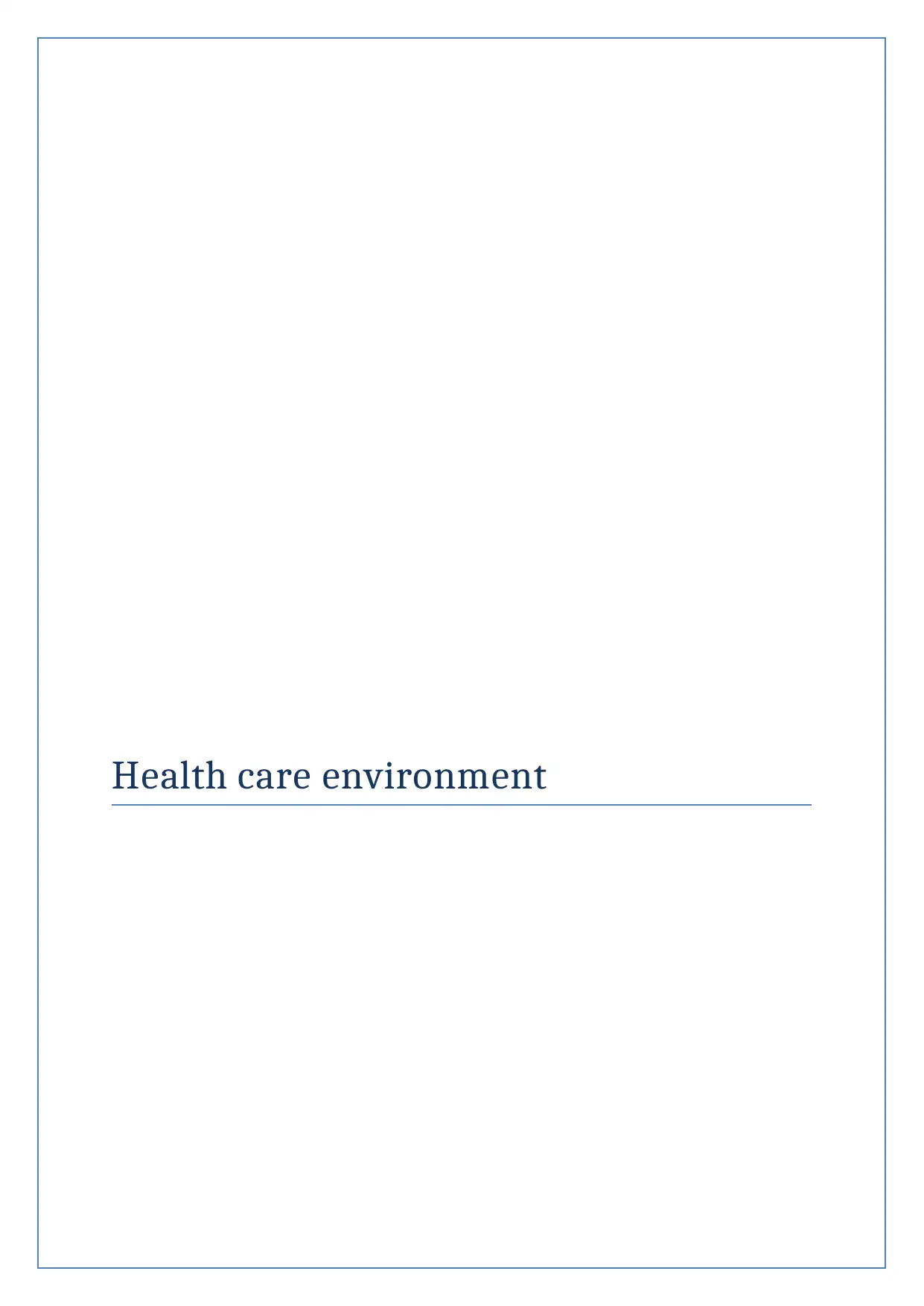
Health care environment
Secure Best Marks with AI Grader
Need help grading? Try our AI Grader for instant feedback on your assignments.
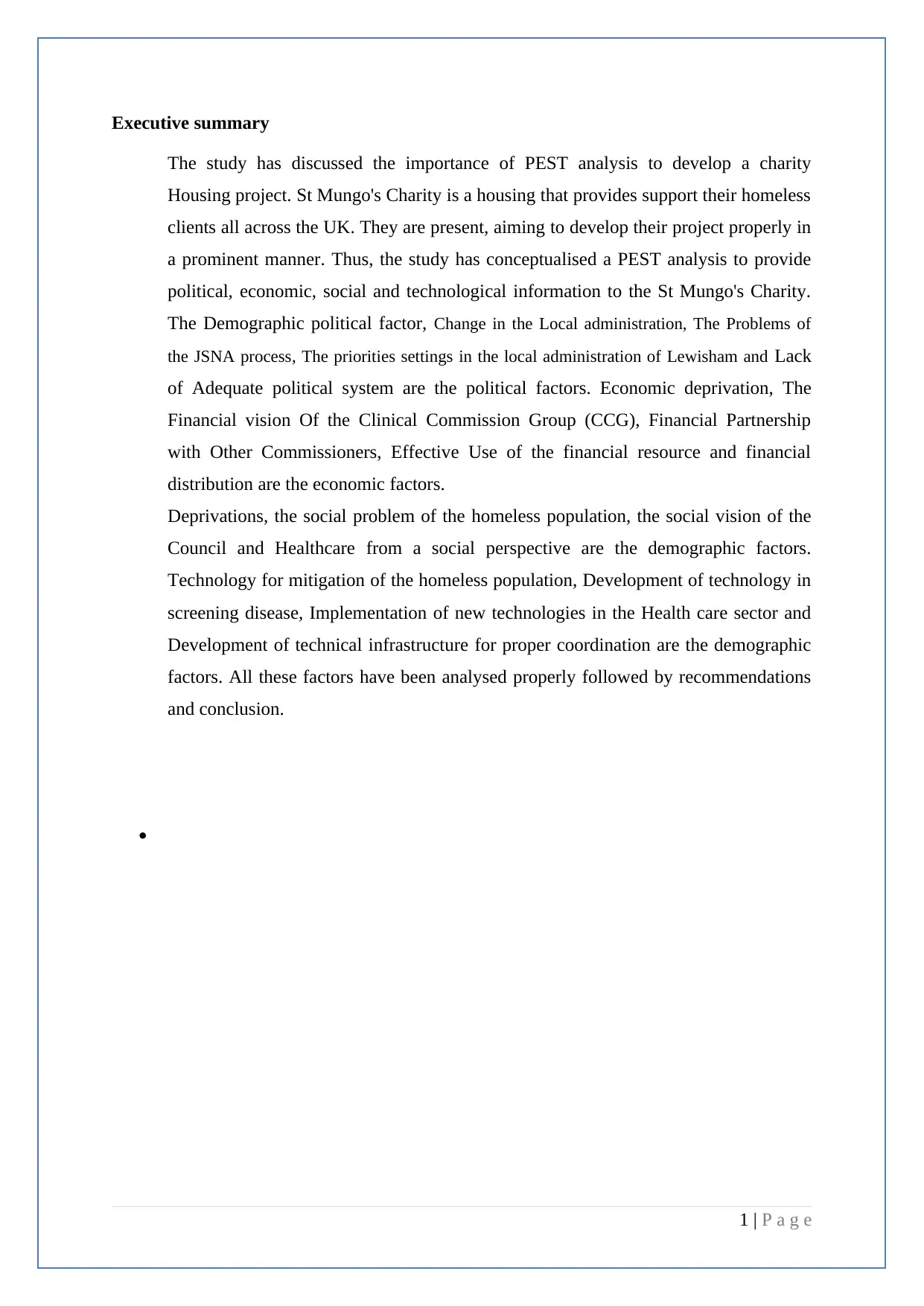
Executive summary
The study has discussed the importance of PEST analysis to develop a charity
Housing project. St Mungo's Charity is a housing that provides support their homeless
clients all across the UK. They are present, aiming to develop their project properly in
a prominent manner. Thus, the study has conceptualised a PEST analysis to provide
political, economic, social and technological information to the St Mungo's Charity.
The Demographic political factor, Change in the Local administration, The Problems of
the JSNA process, The priorities settings in the local administration of Lewisham and Lack
of Adequate political system are the political factors. Economic deprivation, The
Financial vision Of the Clinical Commission Group (CCG), Financial Partnership
with Other Commissioners, Effective Use of the financial resource and financial
distribution are the economic factors.
Deprivations, the social problem of the homeless population, the social vision of the
Council and Healthcare from a social perspective are the demographic factors.
Technology for mitigation of the homeless population, Development of technology in
screening disease, Implementation of new technologies in the Health care sector and
Development of technical infrastructure for proper coordination are the demographic
factors. All these factors have been analysed properly followed by recommendations
and conclusion.
1 | P a g e
The study has discussed the importance of PEST analysis to develop a charity
Housing project. St Mungo's Charity is a housing that provides support their homeless
clients all across the UK. They are present, aiming to develop their project properly in
a prominent manner. Thus, the study has conceptualised a PEST analysis to provide
political, economic, social and technological information to the St Mungo's Charity.
The Demographic political factor, Change in the Local administration, The Problems of
the JSNA process, The priorities settings in the local administration of Lewisham and Lack
of Adequate political system are the political factors. Economic deprivation, The
Financial vision Of the Clinical Commission Group (CCG), Financial Partnership
with Other Commissioners, Effective Use of the financial resource and financial
distribution are the economic factors.
Deprivations, the social problem of the homeless population, the social vision of the
Council and Healthcare from a social perspective are the demographic factors.
Technology for mitigation of the homeless population, Development of technology in
screening disease, Implementation of new technologies in the Health care sector and
Development of technical infrastructure for proper coordination are the demographic
factors. All these factors have been analysed properly followed by recommendations
and conclusion.
1 | P a g e

Table of Contents
Introduction................................................................................................................................2
Analysis......................................................................................................................................2
PEST Table............................................................................................................................2
Discussion of the Points of PEST..........................................................................................6
Recommendation....................................................................................................................8
Conclusion..................................................................................................................................9
References................................................................................................................................10
2 | P a g e
Introduction................................................................................................................................2
Analysis......................................................................................................................................2
PEST Table............................................................................................................................2
Discussion of the Points of PEST..........................................................................................6
Recommendation....................................................................................................................8
Conclusion..................................................................................................................................9
References................................................................................................................................10
2 | P a g e
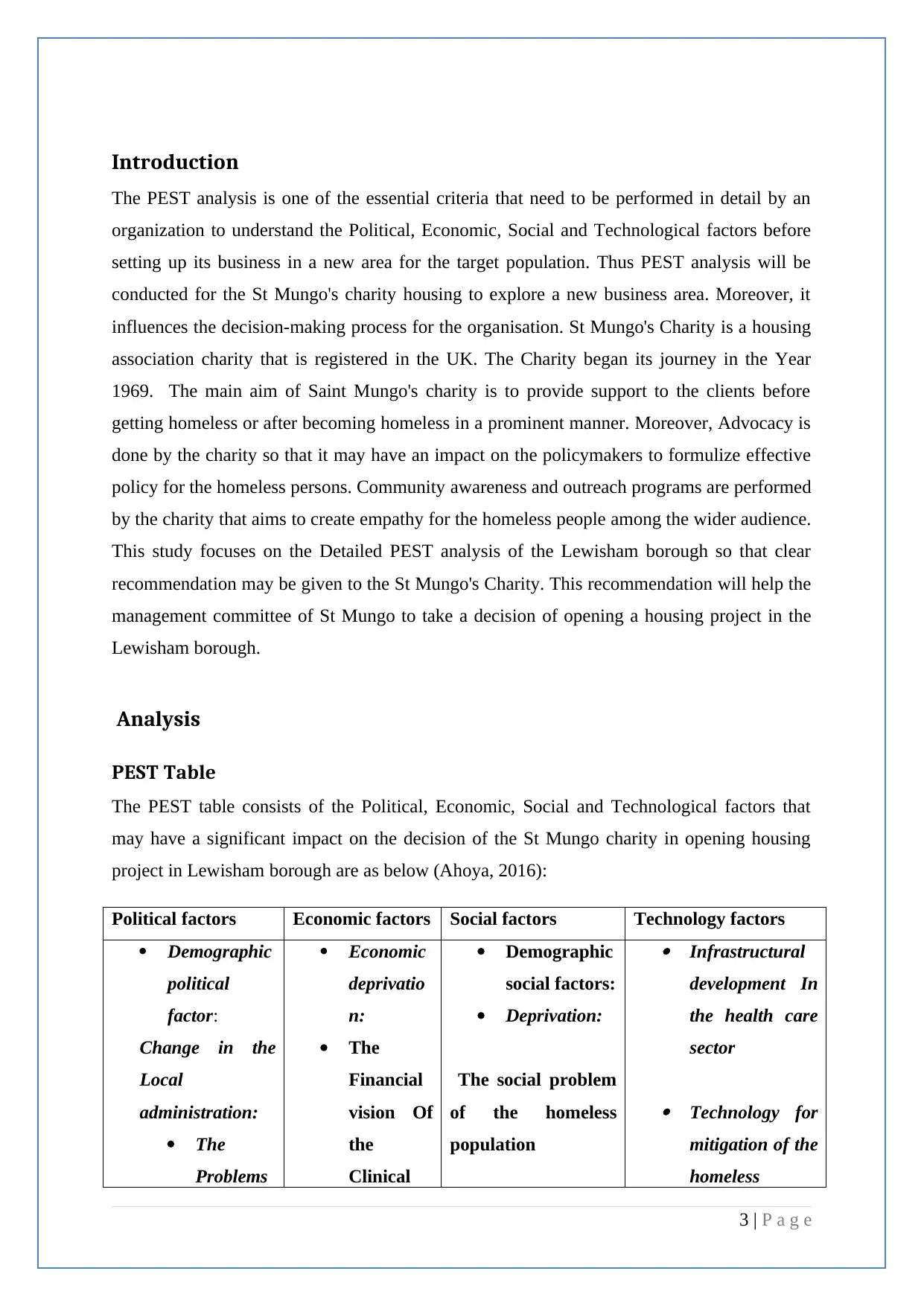
Introduction
The PEST analysis is one of the essential criteria that need to be performed in detail by an
organization to understand the Political, Economic, Social and Technological factors before
setting up its business in a new area for the target population. Thus PEST analysis will be
conducted for the St Mungo's charity housing to explore a new business area. Moreover, it
influences the decision-making process for the organisation. St Mungo's Charity is a housing
association charity that is registered in the UK. The Charity began its journey in the Year
1969. The main aim of Saint Mungo's charity is to provide support to the clients before
getting homeless or after becoming homeless in a prominent manner. Moreover, Advocacy is
done by the charity so that it may have an impact on the policymakers to formulize effective
policy for the homeless persons. Community awareness and outreach programs are performed
by the charity that aims to create empathy for the homeless people among the wider audience.
This study focuses on the Detailed PEST analysis of the Lewisham borough so that clear
recommendation may be given to the St Mungo's Charity. This recommendation will help the
management committee of St Mungo to take a decision of opening a housing project in the
Lewisham borough.
Analysis
PEST Table
The PEST table consists of the Political, Economic, Social and Technological factors that
may have a significant impact on the decision of the St Mungo charity in opening housing
project in Lewisham borough are as below (Ahoya, 2016):
Political factors Economic factors Social factors Technology factors
Demographic
political
factor:
Change in the
Local
administration:
The
Problems
Economic
deprivatio
n:
The
Financial
vision Of
the
Clinical
Demographic
social factors:
Deprivation:
The social problem
of the homeless
population
Infrastructural
development In
the health care
sector
Technology for
mitigation of the
homeless
3 | P a g e
The PEST analysis is one of the essential criteria that need to be performed in detail by an
organization to understand the Political, Economic, Social and Technological factors before
setting up its business in a new area for the target population. Thus PEST analysis will be
conducted for the St Mungo's charity housing to explore a new business area. Moreover, it
influences the decision-making process for the organisation. St Mungo's Charity is a housing
association charity that is registered in the UK. The Charity began its journey in the Year
1969. The main aim of Saint Mungo's charity is to provide support to the clients before
getting homeless or after becoming homeless in a prominent manner. Moreover, Advocacy is
done by the charity so that it may have an impact on the policymakers to formulize effective
policy for the homeless persons. Community awareness and outreach programs are performed
by the charity that aims to create empathy for the homeless people among the wider audience.
This study focuses on the Detailed PEST analysis of the Lewisham borough so that clear
recommendation may be given to the St Mungo's Charity. This recommendation will help the
management committee of St Mungo to take a decision of opening a housing project in the
Lewisham borough.
Analysis
PEST Table
The PEST table consists of the Political, Economic, Social and Technological factors that
may have a significant impact on the decision of the St Mungo charity in opening housing
project in Lewisham borough are as below (Ahoya, 2016):
Political factors Economic factors Social factors Technology factors
Demographic
political
factor:
Change in the
Local
administration:
The
Problems
Economic
deprivatio
n:
The
Financial
vision Of
the
Clinical
Demographic
social factors:
Deprivation:
The social problem
of the homeless
population
Infrastructural
development In
the health care
sector
Technology for
mitigation of the
homeless
3 | P a g e
Secure Best Marks with AI Grader
Need help grading? Try our AI Grader for instant feedback on your assignments.
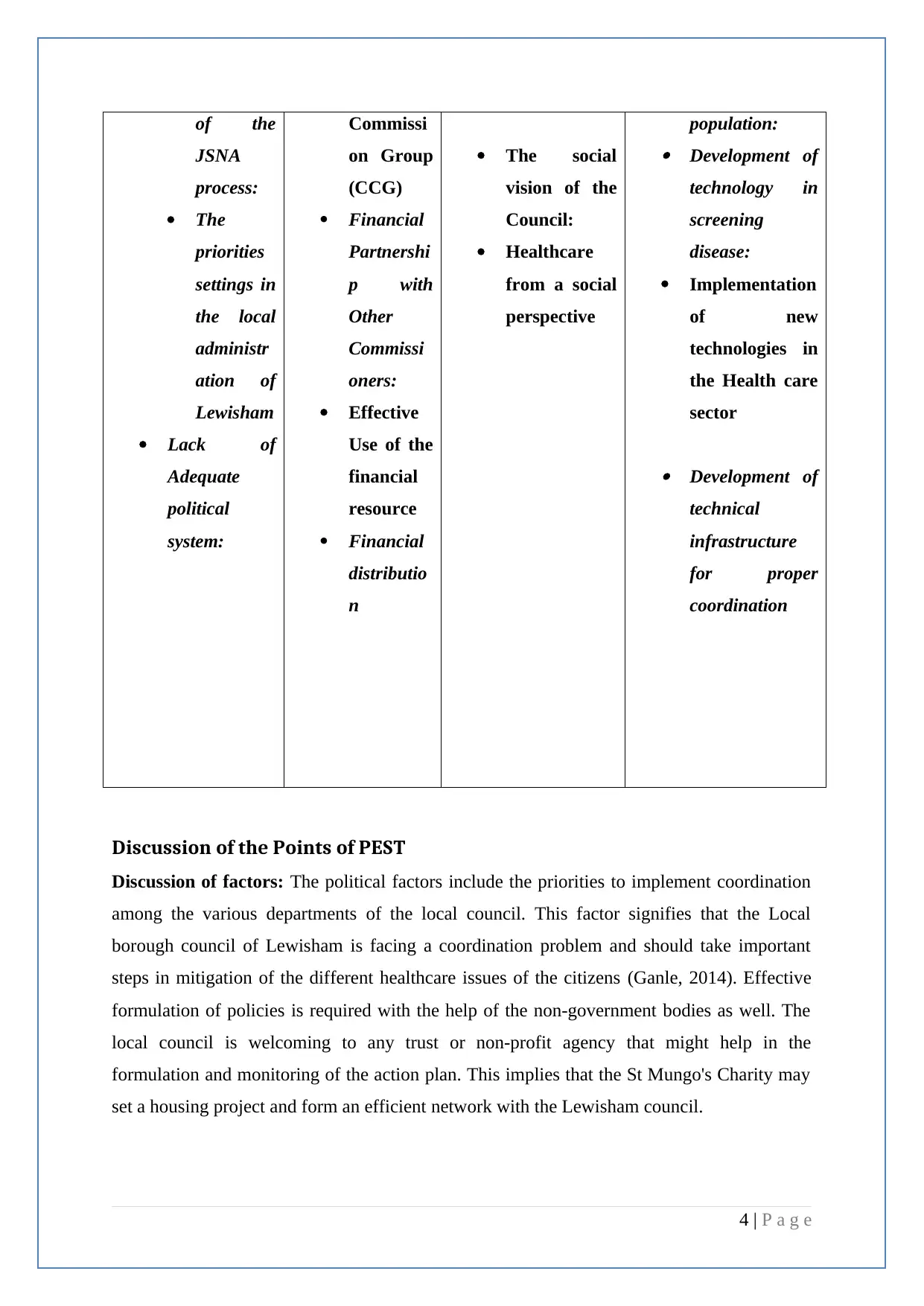
of the
JSNA
process:
The
priorities
settings in
the local
administr
ation of
Lewisham
Lack of
Adequate
political
system:
Commissi
on Group
(CCG)
Financial
Partnershi
p with
Other
Commissi
oners:
Effective
Use of the
financial
resource
Financial
distributio
n
The social
vision of the
Council:
Healthcare
from a social
perspective
population:
Development of
technology in
screening
disease:
Implementation
of new
technologies in
the Health care
sector
Development of
technical
infrastructure
for proper
coordination
Discussion of the Points of PEST
Discussion of factors: The political factors include the priorities to implement coordination
among the various departments of the local council. This factor signifies that the Local
borough council of Lewisham is facing a coordination problem and should take important
steps in mitigation of the different healthcare issues of the citizens (Ganle, 2014). Effective
formulation of policies is required with the help of the non-government bodies as well. The
local council is welcoming to any trust or non-profit agency that might help in the
formulation and monitoring of the action plan. This implies that the St Mungo's Charity may
set a housing project and form an efficient network with the Lewisham council.
4 | P a g e
JSNA
process:
The
priorities
settings in
the local
administr
ation of
Lewisham
Lack of
Adequate
political
system:
Commissi
on Group
(CCG)
Financial
Partnershi
p with
Other
Commissi
oners:
Effective
Use of the
financial
resource
Financial
distributio
n
The social
vision of the
Council:
Healthcare
from a social
perspective
population:
Development of
technology in
screening
disease:
Implementation
of new
technologies in
the Health care
sector
Development of
technical
infrastructure
for proper
coordination
Discussion of the Points of PEST
Discussion of factors: The political factors include the priorities to implement coordination
among the various departments of the local council. This factor signifies that the Local
borough council of Lewisham is facing a coordination problem and should take important
steps in mitigation of the different healthcare issues of the citizens (Ganle, 2014). Effective
formulation of policies is required with the help of the non-government bodies as well. The
local council is welcoming to any trust or non-profit agency that might help in the
formulation and monitoring of the action plan. This implies that the St Mungo's Charity may
set a housing project and form an efficient network with the Lewisham council.
4 | P a g e
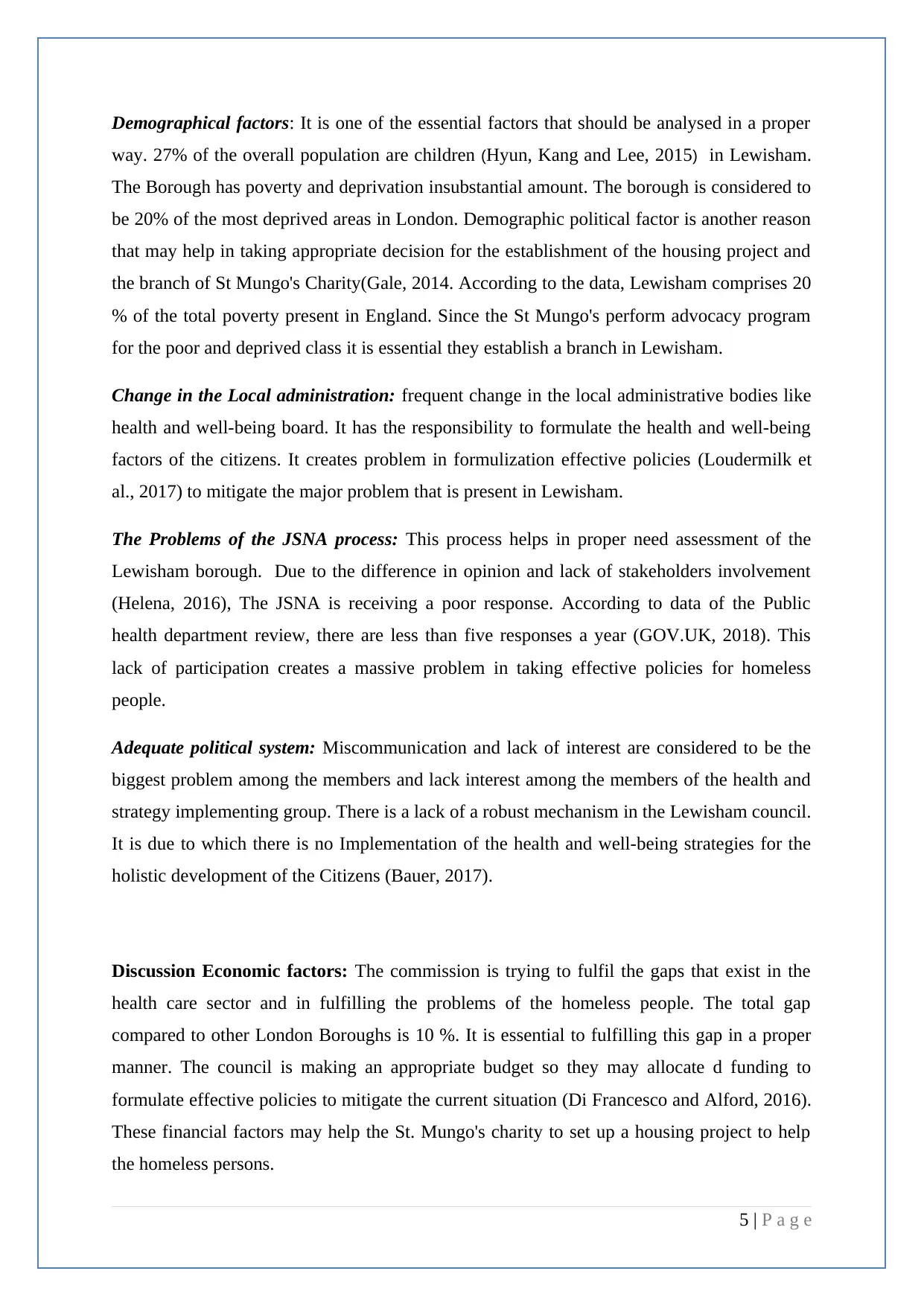
Demographical factors: It is one of the essential factors that should be analysed in a proper
way. 27% of the overall population are children (Hyun, Kang and Lee, 2015) in Lewisham.
The Borough has poverty and deprivation insubstantial amount. The borough is considered to
be 20% of the most deprived areas in London. Demographic political factor is another reason
that may help in taking appropriate decision for the establishment of the housing project and
the branch of St Mungo's Charity(Gale, 2014. According to the data, Lewisham comprises 20
% of the total poverty present in England. Since the St Mungo's perform advocacy program
for the poor and deprived class it is essential they establish a branch in Lewisham.
Change in the Local administration: frequent change in the local administrative bodies like
health and well-being board. It has the responsibility to formulate the health and well-being
factors of the citizens. It creates problem in formulization effective policies (Loudermilk et
al., 2017) to mitigate the major problem that is present in Lewisham.
The Problems of the JSNA process: This process helps in proper need assessment of the
Lewisham borough. Due to the difference in opinion and lack of stakeholders involvement
(Helena, 2016), The JSNA is receiving a poor response. According to data of the Public
health department review, there are less than five responses a year (GOV.UK, 2018). This
lack of participation creates a massive problem in taking effective policies for homeless
people.
Adequate political system: Miscommunication and lack of interest are considered to be the
biggest problem among the members and lack interest among the members of the health and
strategy implementing group. There is a lack of a robust mechanism in the Lewisham council.
It is due to which there is no Implementation of the health and well-being strategies for the
holistic development of the Citizens (Bauer, 2017).
Discussion Economic factors: The commission is trying to fulfil the gaps that exist in the
health care sector and in fulfilling the problems of the homeless people. The total gap
compared to other London Boroughs is 10 %. It is essential to fulfilling this gap in a proper
manner. The council is making an appropriate budget so they may allocate d funding to
formulate effective policies to mitigate the current situation (Di Francesco and Alford, 2016).
These financial factors may help the St. Mungo's charity to set up a housing project to help
the homeless persons.
5 | P a g e
way. 27% of the overall population are children (Hyun, Kang and Lee, 2015) in Lewisham.
The Borough has poverty and deprivation insubstantial amount. The borough is considered to
be 20% of the most deprived areas in London. Demographic political factor is another reason
that may help in taking appropriate decision for the establishment of the housing project and
the branch of St Mungo's Charity(Gale, 2014. According to the data, Lewisham comprises 20
% of the total poverty present in England. Since the St Mungo's perform advocacy program
for the poor and deprived class it is essential they establish a branch in Lewisham.
Change in the Local administration: frequent change in the local administrative bodies like
health and well-being board. It has the responsibility to formulate the health and well-being
factors of the citizens. It creates problem in formulization effective policies (Loudermilk et
al., 2017) to mitigate the major problem that is present in Lewisham.
The Problems of the JSNA process: This process helps in proper need assessment of the
Lewisham borough. Due to the difference in opinion and lack of stakeholders involvement
(Helena, 2016), The JSNA is receiving a poor response. According to data of the Public
health department review, there are less than five responses a year (GOV.UK, 2018). This
lack of participation creates a massive problem in taking effective policies for homeless
people.
Adequate political system: Miscommunication and lack of interest are considered to be the
biggest problem among the members and lack interest among the members of the health and
strategy implementing group. There is a lack of a robust mechanism in the Lewisham council.
It is due to which there is no Implementation of the health and well-being strategies for the
holistic development of the Citizens (Bauer, 2017).
Discussion Economic factors: The commission is trying to fulfil the gaps that exist in the
health care sector and in fulfilling the problems of the homeless people. The total gap
compared to other London Boroughs is 10 %. It is essential to fulfilling this gap in a proper
manner. The council is making an appropriate budget so they may allocate d funding to
formulate effective policies to mitigate the current situation (Di Francesco and Alford, 2016).
These financial factors may help the St. Mungo's charity to set up a housing project to help
the homeless persons.
5 | P a g e
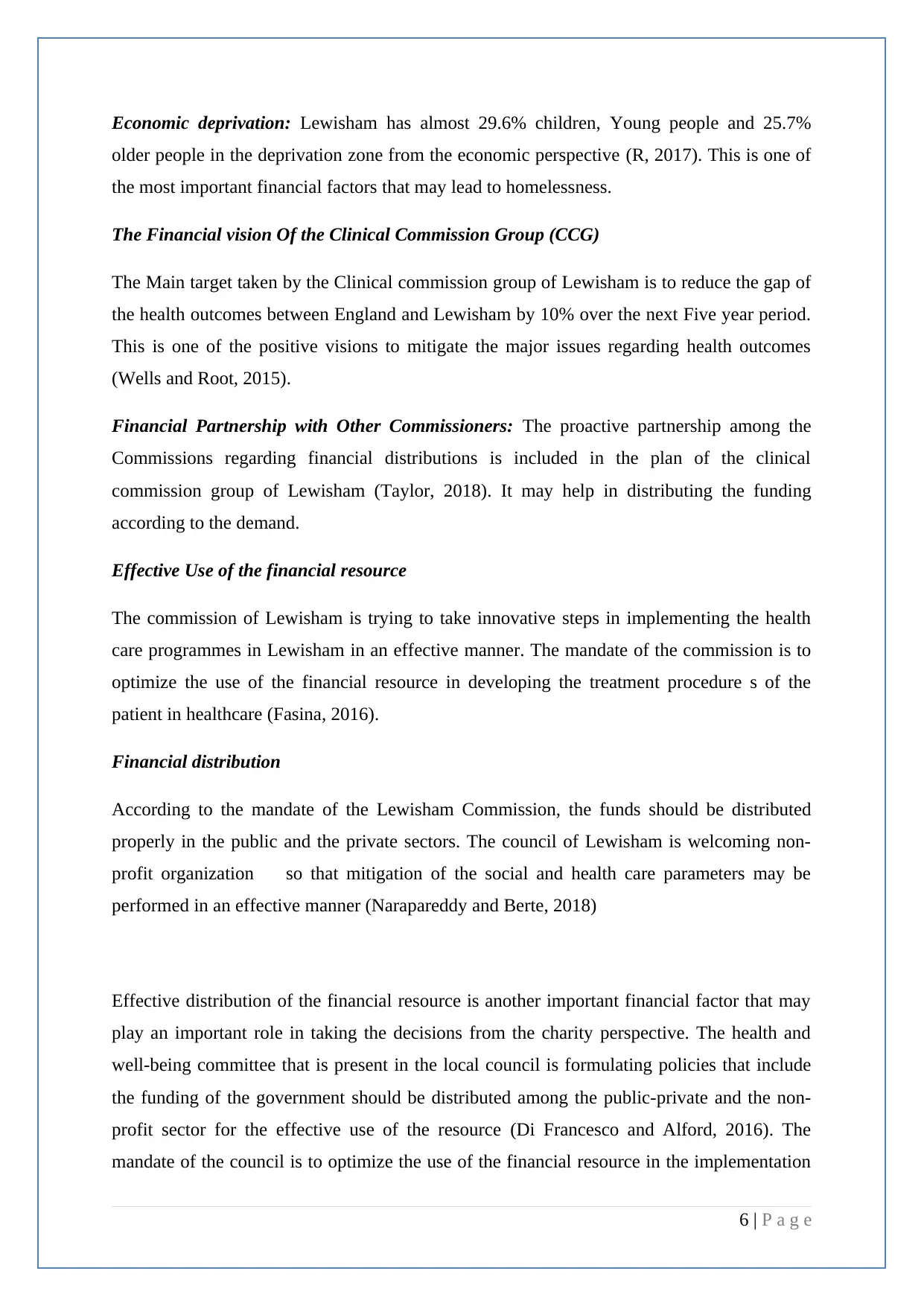
Economic deprivation: Lewisham has almost 29.6% children, Young people and 25.7%
older people in the deprivation zone from the economic perspective (R, 2017). This is one of
the most important financial factors that may lead to homelessness.
The Financial vision Of the Clinical Commission Group (CCG)
The Main target taken by the Clinical commission group of Lewisham is to reduce the gap of
the health outcomes between England and Lewisham by 10% over the next Five year period.
This is one of the positive visions to mitigate the major issues regarding health outcomes
(Wells and Root, 2015).
Financial Partnership with Other Commissioners: The proactive partnership among the
Commissions regarding financial distributions is included in the plan of the clinical
commission group of Lewisham (Taylor, 2018). It may help in distributing the funding
according to the demand.
Effective Use of the financial resource
The commission of Lewisham is trying to take innovative steps in implementing the health
care programmes in Lewisham in an effective manner. The mandate of the commission is to
optimize the use of the financial resource in developing the treatment procedure s of the
patient in healthcare (Fasina, 2016).
Financial distribution
According to the mandate of the Lewisham Commission, the funds should be distributed
properly in the public and the private sectors. The council of Lewisham is welcoming non-
profit organization so that mitigation of the social and health care parameters may be
performed in an effective manner (Narapareddy and Berte, 2018)
Effective distribution of the financial resource is another important financial factor that may
play an important role in taking the decisions from the charity perspective. The health and
well-being committee that is present in the local council is formulating policies that include
the funding of the government should be distributed among the public-private and the non-
profit sector for the effective use of the resource (Di Francesco and Alford, 2016). The
mandate of the council is to optimize the use of the financial resource in the implementation
6 | P a g e
older people in the deprivation zone from the economic perspective (R, 2017). This is one of
the most important financial factors that may lead to homelessness.
The Financial vision Of the Clinical Commission Group (CCG)
The Main target taken by the Clinical commission group of Lewisham is to reduce the gap of
the health outcomes between England and Lewisham by 10% over the next Five year period.
This is one of the positive visions to mitigate the major issues regarding health outcomes
(Wells and Root, 2015).
Financial Partnership with Other Commissioners: The proactive partnership among the
Commissions regarding financial distributions is included in the plan of the clinical
commission group of Lewisham (Taylor, 2018). It may help in distributing the funding
according to the demand.
Effective Use of the financial resource
The commission of Lewisham is trying to take innovative steps in implementing the health
care programmes in Lewisham in an effective manner. The mandate of the commission is to
optimize the use of the financial resource in developing the treatment procedure s of the
patient in healthcare (Fasina, 2016).
Financial distribution
According to the mandate of the Lewisham Commission, the funds should be distributed
properly in the public and the private sectors. The council of Lewisham is welcoming non-
profit organization so that mitigation of the social and health care parameters may be
performed in an effective manner (Narapareddy and Berte, 2018)
Effective distribution of the financial resource is another important financial factor that may
play an important role in taking the decisions from the charity perspective. The health and
well-being committee that is present in the local council is formulating policies that include
the funding of the government should be distributed among the public-private and the non-
profit sector for the effective use of the resource (Di Francesco and Alford, 2016). The
mandate of the council is to optimize the use of the financial resource in the implementation
6 | P a g e
Paraphrase This Document
Need a fresh take? Get an instant paraphrase of this document with our AI Paraphraser

of the action plan. The financial resource is distributed in a prominent way then it supports
the intention of the St Mungo’s charity to open a housing project in the Lewisham for the
holistic development of the society.
Discussion on the social factors:
The Social problem of Homelessness is one of the significant issues of Lewisham. According
to the current data, it suggests that more 1800 citizens are homeless. The majority of the
homeless person includes females and single parents. These two comprise about 90% of the
total homeless population. According to the researchers, there is a high demand for shelters
among the large section of the population. This homelessness is causing mental trauma and
different kind of mental and physical illness is occurring among the citizens of Lewisham
(Frueh, 2015). Besides that, the house which is available for rent is charging far more rent
than the financial capacity of the homeless population. This implies that there is a growing
demand for shelter in Lewisham.
Demographic social factors:
According to the council data, there is a significant amount of minor population present in
Lewisham Borough. 46.5% of the population are from black and minority groups(Hyun,
Kang and Lee, 2015).
Deprivation:
This is another essential Social factor. According to the multiple deprivation indexes,
Lewisham has ranked 31st. There are total 354 local authorities in England. This implies the
population is deprived form perspective of ethnicity.
The social problem of the homeless population
This is a major problem that is causing social unrest in the locality. The private rent of the
houses is much higher compared to the income of the population. According to the social
structure, it is seen that majority of female and single parents are becoming homeless At
present there are almost 1800 people who are homeless due to the social and financial
problem (Heiskanen, 2017).
The social vision of the Council:
7 | P a g e
the intention of the St Mungo’s charity to open a housing project in the Lewisham for the
holistic development of the society.
Discussion on the social factors:
The Social problem of Homelessness is one of the significant issues of Lewisham. According
to the current data, it suggests that more 1800 citizens are homeless. The majority of the
homeless person includes females and single parents. These two comprise about 90% of the
total homeless population. According to the researchers, there is a high demand for shelters
among the large section of the population. This homelessness is causing mental trauma and
different kind of mental and physical illness is occurring among the citizens of Lewisham
(Frueh, 2015). Besides that, the house which is available for rent is charging far more rent
than the financial capacity of the homeless population. This implies that there is a growing
demand for shelter in Lewisham.
Demographic social factors:
According to the council data, there is a significant amount of minor population present in
Lewisham Borough. 46.5% of the population are from black and minority groups(Hyun,
Kang and Lee, 2015).
Deprivation:
This is another essential Social factor. According to the multiple deprivation indexes,
Lewisham has ranked 31st. There are total 354 local authorities in England. This implies the
population is deprived form perspective of ethnicity.
The social problem of the homeless population
This is a major problem that is causing social unrest in the locality. The private rent of the
houses is much higher compared to the income of the population. According to the social
structure, it is seen that majority of female and single parents are becoming homeless At
present there are almost 1800 people who are homeless due to the social and financial
problem (Heiskanen, 2017).
The social vision of the Council:
7 | P a g e
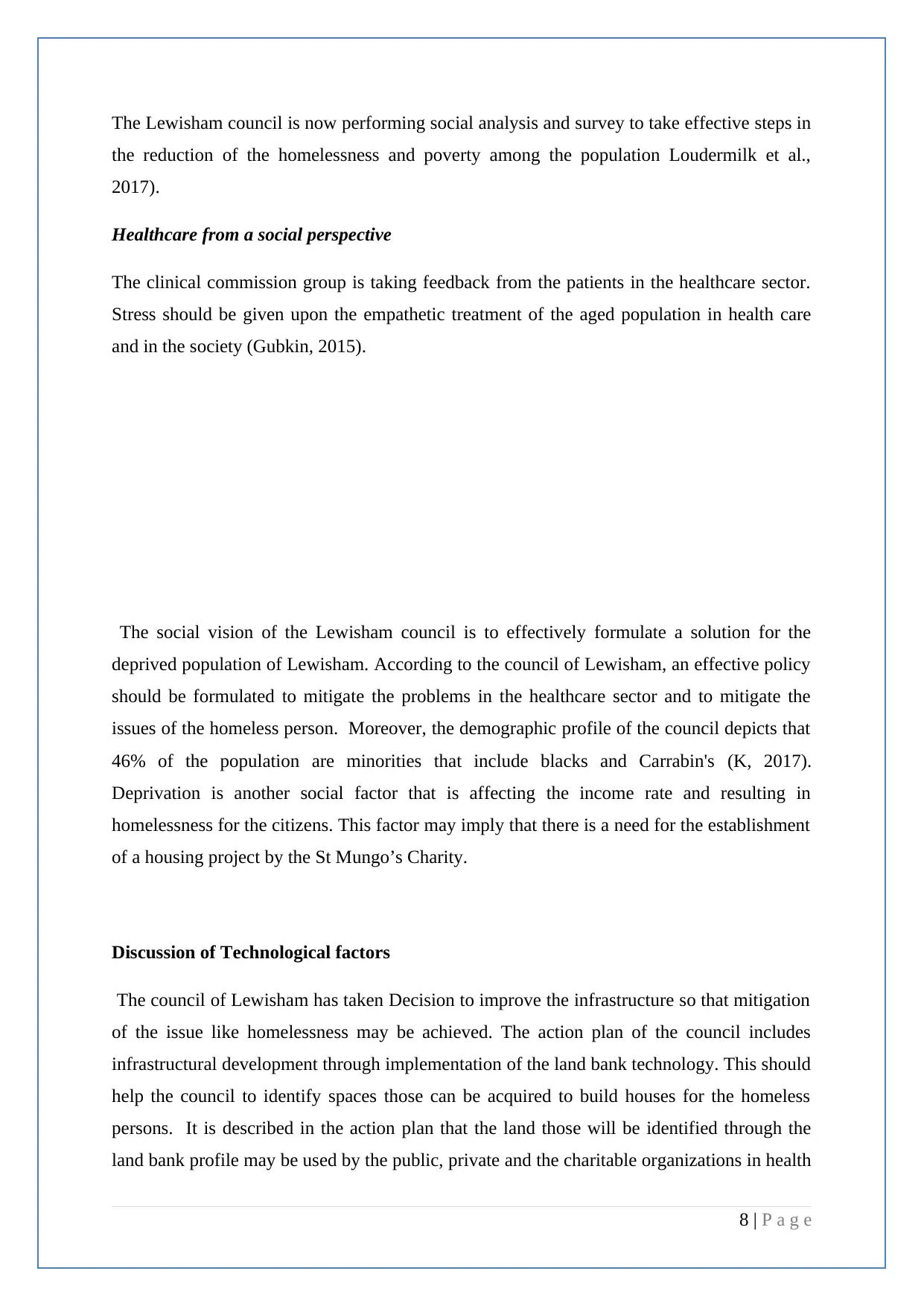
The Lewisham council is now performing social analysis and survey to take effective steps in
the reduction of the homelessness and poverty among the population Loudermilk et al.,
2017).
Healthcare from a social perspective
The clinical commission group is taking feedback from the patients in the healthcare sector.
Stress should be given upon the empathetic treatment of the aged population in health care
and in the society (Gubkin, 2015).
The social vision of the Lewisham council is to effectively formulate a solution for the
deprived population of Lewisham. According to the council of Lewisham, an effective policy
should be formulated to mitigate the problems in the healthcare sector and to mitigate the
issues of the homeless person. Moreover, the demographic profile of the council depicts that
46% of the population are minorities that include blacks and Carrabin's (K, 2017).
Deprivation is another social factor that is affecting the income rate and resulting in
homelessness for the citizens. This factor may imply that there is a need for the establishment
of a housing project by the St Mungo’s Charity.
Discussion of Technological factors
The council of Lewisham has taken Decision to improve the infrastructure so that mitigation
of the issue like homelessness may be achieved. The action plan of the council includes
infrastructural development through implementation of the land bank technology. This should
help the council to identify spaces those can be acquired to build houses for the homeless
persons. It is described in the action plan that the land those will be identified through the
land bank profile may be used by the public, private and the charitable organizations in health
8 | P a g e
the reduction of the homelessness and poverty among the population Loudermilk et al.,
2017).
Healthcare from a social perspective
The clinical commission group is taking feedback from the patients in the healthcare sector.
Stress should be given upon the empathetic treatment of the aged population in health care
and in the society (Gubkin, 2015).
The social vision of the Lewisham council is to effectively formulate a solution for the
deprived population of Lewisham. According to the council of Lewisham, an effective policy
should be formulated to mitigate the problems in the healthcare sector and to mitigate the
issues of the homeless person. Moreover, the demographic profile of the council depicts that
46% of the population are minorities that include blacks and Carrabin's (K, 2017).
Deprivation is another social factor that is affecting the income rate and resulting in
homelessness for the citizens. This factor may imply that there is a need for the establishment
of a housing project by the St Mungo’s Charity.
Discussion of Technological factors
The council of Lewisham has taken Decision to improve the infrastructure so that mitigation
of the issue like homelessness may be achieved. The action plan of the council includes
infrastructural development through implementation of the land bank technology. This should
help the council to identify spaces those can be acquired to build houses for the homeless
persons. It is described in the action plan that the land those will be identified through the
land bank profile may be used by the public, private and the charitable organizations in health
8 | P a g e
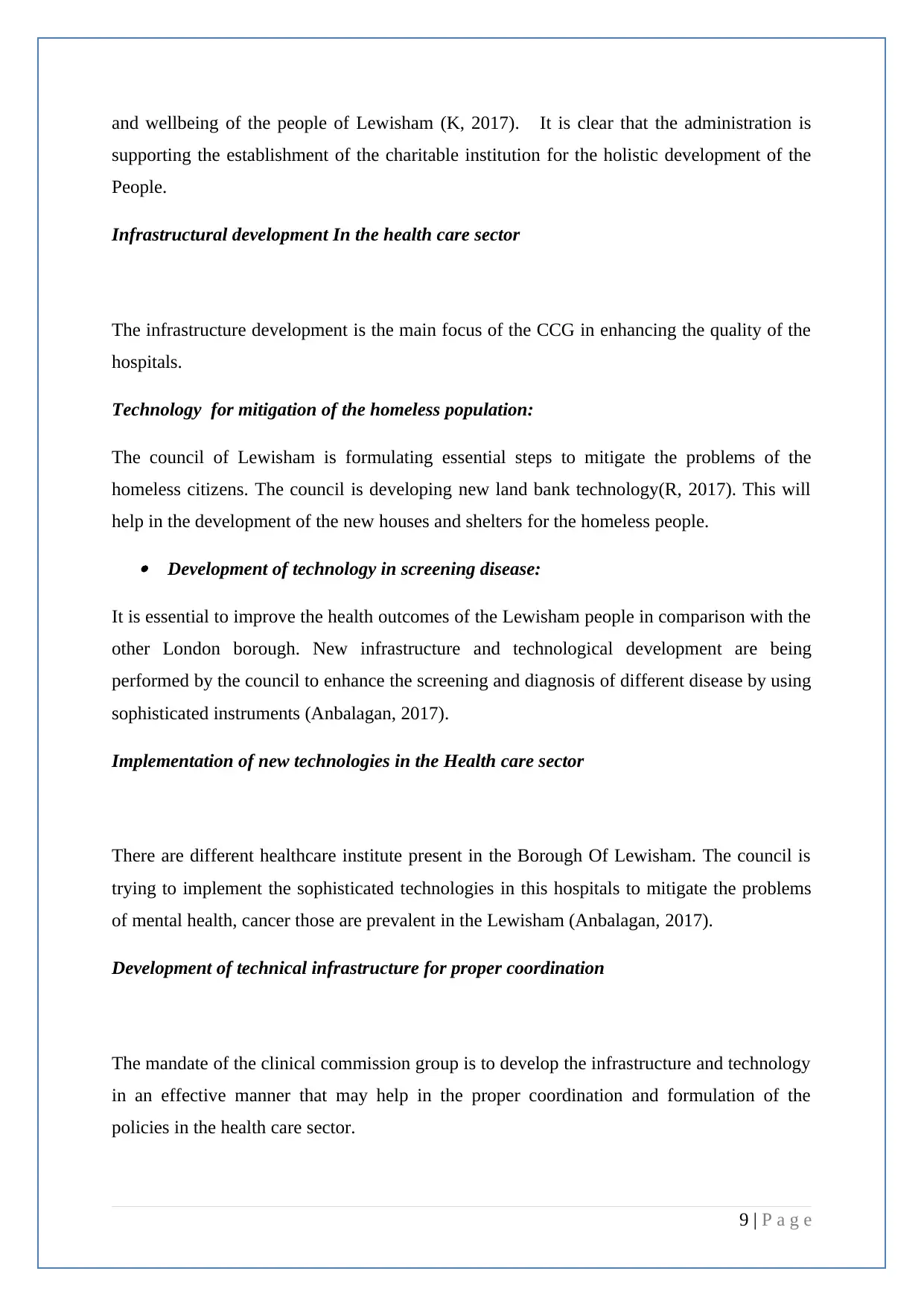
and wellbeing of the people of Lewisham (K, 2017). It is clear that the administration is
supporting the establishment of the charitable institution for the holistic development of the
People.
Infrastructural development In the health care sector
The infrastructure development is the main focus of the CCG in enhancing the quality of the
hospitals.
Technology for mitigation of the homeless population:
The council of Lewisham is formulating essential steps to mitigate the problems of the
homeless citizens. The council is developing new land bank technology(R, 2017). This will
help in the development of the new houses and shelters for the homeless people.
Development of technology in screening disease:
It is essential to improve the health outcomes of the Lewisham people in comparison with the
other London borough. New infrastructure and technological development are being
performed by the council to enhance the screening and diagnosis of different disease by using
sophisticated instruments (Anbalagan, 2017).
Implementation of new technologies in the Health care sector
There are different healthcare institute present in the Borough Of Lewisham. The council is
trying to implement the sophisticated technologies in this hospitals to mitigate the problems
of mental health, cancer those are prevalent in the Lewisham (Anbalagan, 2017).
Development of technical infrastructure for proper coordination
The mandate of the clinical commission group is to develop the infrastructure and technology
in an effective manner that may help in the proper coordination and formulation of the
policies in the health care sector.
9 | P a g e
supporting the establishment of the charitable institution for the holistic development of the
People.
Infrastructural development In the health care sector
The infrastructure development is the main focus of the CCG in enhancing the quality of the
hospitals.
Technology for mitigation of the homeless population:
The council of Lewisham is formulating essential steps to mitigate the problems of the
homeless citizens. The council is developing new land bank technology(R, 2017). This will
help in the development of the new houses and shelters for the homeless people.
Development of technology in screening disease:
It is essential to improve the health outcomes of the Lewisham people in comparison with the
other London borough. New infrastructure and technological development are being
performed by the council to enhance the screening and diagnosis of different disease by using
sophisticated instruments (Anbalagan, 2017).
Implementation of new technologies in the Health care sector
There are different healthcare institute present in the Borough Of Lewisham. The council is
trying to implement the sophisticated technologies in this hospitals to mitigate the problems
of mental health, cancer those are prevalent in the Lewisham (Anbalagan, 2017).
Development of technical infrastructure for proper coordination
The mandate of the clinical commission group is to develop the infrastructure and technology
in an effective manner that may help in the proper coordination and formulation of the
policies in the health care sector.
9 | P a g e
Secure Best Marks with AI Grader
Need help grading? Try our AI Grader for instant feedback on your assignments.
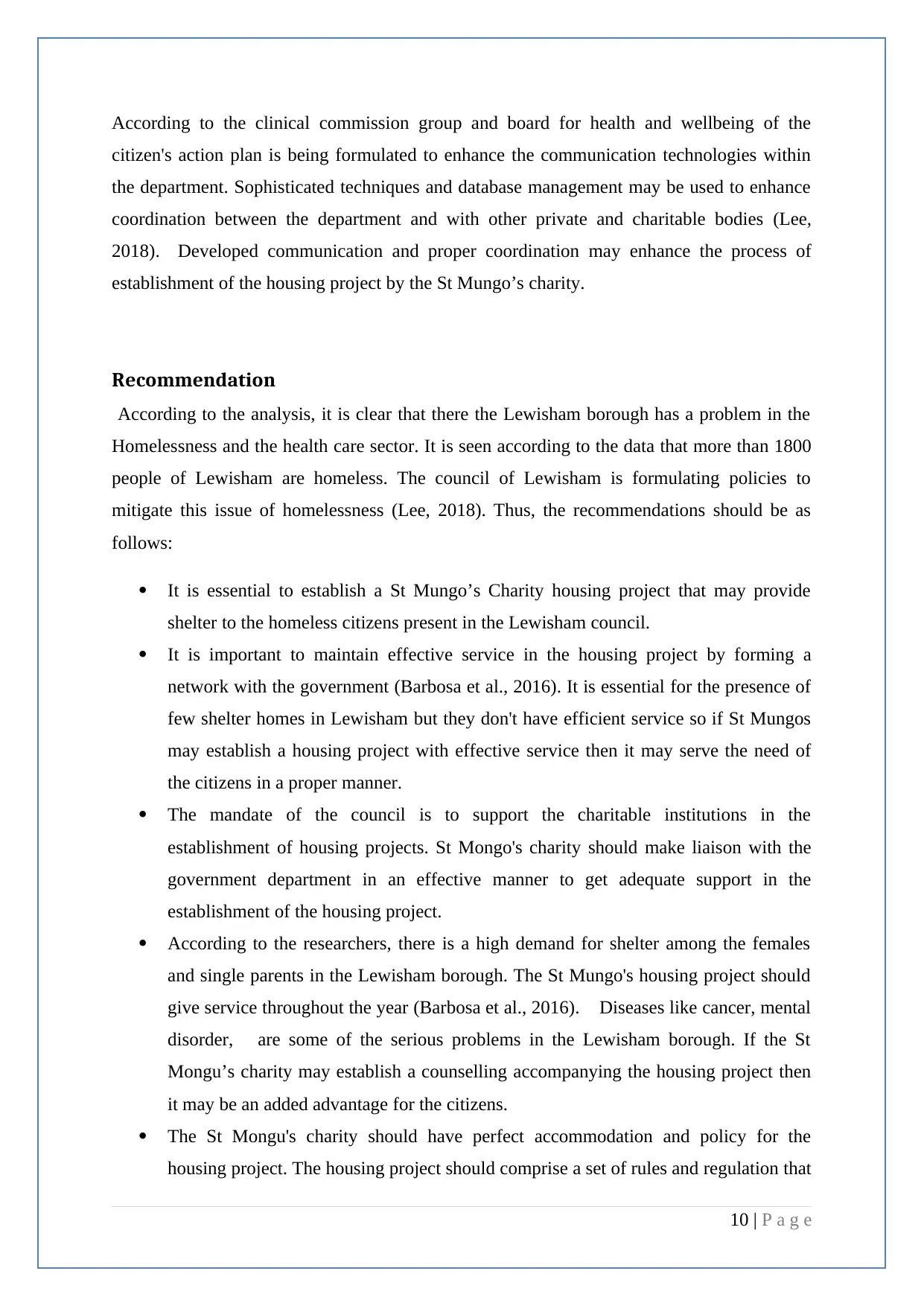
According to the clinical commission group and board for health and wellbeing of the
citizen's action plan is being formulated to enhance the communication technologies within
the department. Sophisticated techniques and database management may be used to enhance
coordination between the department and with other private and charitable bodies (Lee,
2018). Developed communication and proper coordination may enhance the process of
establishment of the housing project by the St Mungo’s charity.
Recommendation
According to the analysis, it is clear that there the Lewisham borough has a problem in the
Homelessness and the health care sector. It is seen according to the data that more than 1800
people of Lewisham are homeless. The council of Lewisham is formulating policies to
mitigate this issue of homelessness (Lee, 2018). Thus, the recommendations should be as
follows:
It is essential to establish a St Mungo’s Charity housing project that may provide
shelter to the homeless citizens present in the Lewisham council.
It is important to maintain effective service in the housing project by forming a
network with the government (Barbosa et al., 2016). It is essential for the presence of
few shelter homes in Lewisham but they don't have efficient service so if St Mungos
may establish a housing project with effective service then it may serve the need of
the citizens in a proper manner.
The mandate of the council is to support the charitable institutions in the
establishment of housing projects. St Mongo's charity should make liaison with the
government department in an effective manner to get adequate support in the
establishment of the housing project.
According to the researchers, there is a high demand for shelter among the females
and single parents in the Lewisham borough. The St Mungo's housing project should
give service throughout the year (Barbosa et al., 2016). Diseases like cancer, mental
disorder, are some of the serious problems in the Lewisham borough. If the St
Mongu’s charity may establish a counselling accompanying the housing project then
it may be an added advantage for the citizens.
The St Mongu's charity should have perfect accommodation and policy for the
housing project. The housing project should comprise a set of rules and regulation that
10 | P a g e
citizen's action plan is being formulated to enhance the communication technologies within
the department. Sophisticated techniques and database management may be used to enhance
coordination between the department and with other private and charitable bodies (Lee,
2018). Developed communication and proper coordination may enhance the process of
establishment of the housing project by the St Mungo’s charity.
Recommendation
According to the analysis, it is clear that there the Lewisham borough has a problem in the
Homelessness and the health care sector. It is seen according to the data that more than 1800
people of Lewisham are homeless. The council of Lewisham is formulating policies to
mitigate this issue of homelessness (Lee, 2018). Thus, the recommendations should be as
follows:
It is essential to establish a St Mungo’s Charity housing project that may provide
shelter to the homeless citizens present in the Lewisham council.
It is important to maintain effective service in the housing project by forming a
network with the government (Barbosa et al., 2016). It is essential for the presence of
few shelter homes in Lewisham but they don't have efficient service so if St Mungos
may establish a housing project with effective service then it may serve the need of
the citizens in a proper manner.
The mandate of the council is to support the charitable institutions in the
establishment of housing projects. St Mongo's charity should make liaison with the
government department in an effective manner to get adequate support in the
establishment of the housing project.
According to the researchers, there is a high demand for shelter among the females
and single parents in the Lewisham borough. The St Mungo's housing project should
give service throughout the year (Barbosa et al., 2016). Diseases like cancer, mental
disorder, are some of the serious problems in the Lewisham borough. If the St
Mongu’s charity may establish a counselling accompanying the housing project then
it may be an added advantage for the citizens.
The St Mongu's charity should have perfect accommodation and policy for the
housing project. The housing project should comprise a set of rules and regulation that
10 | P a g e
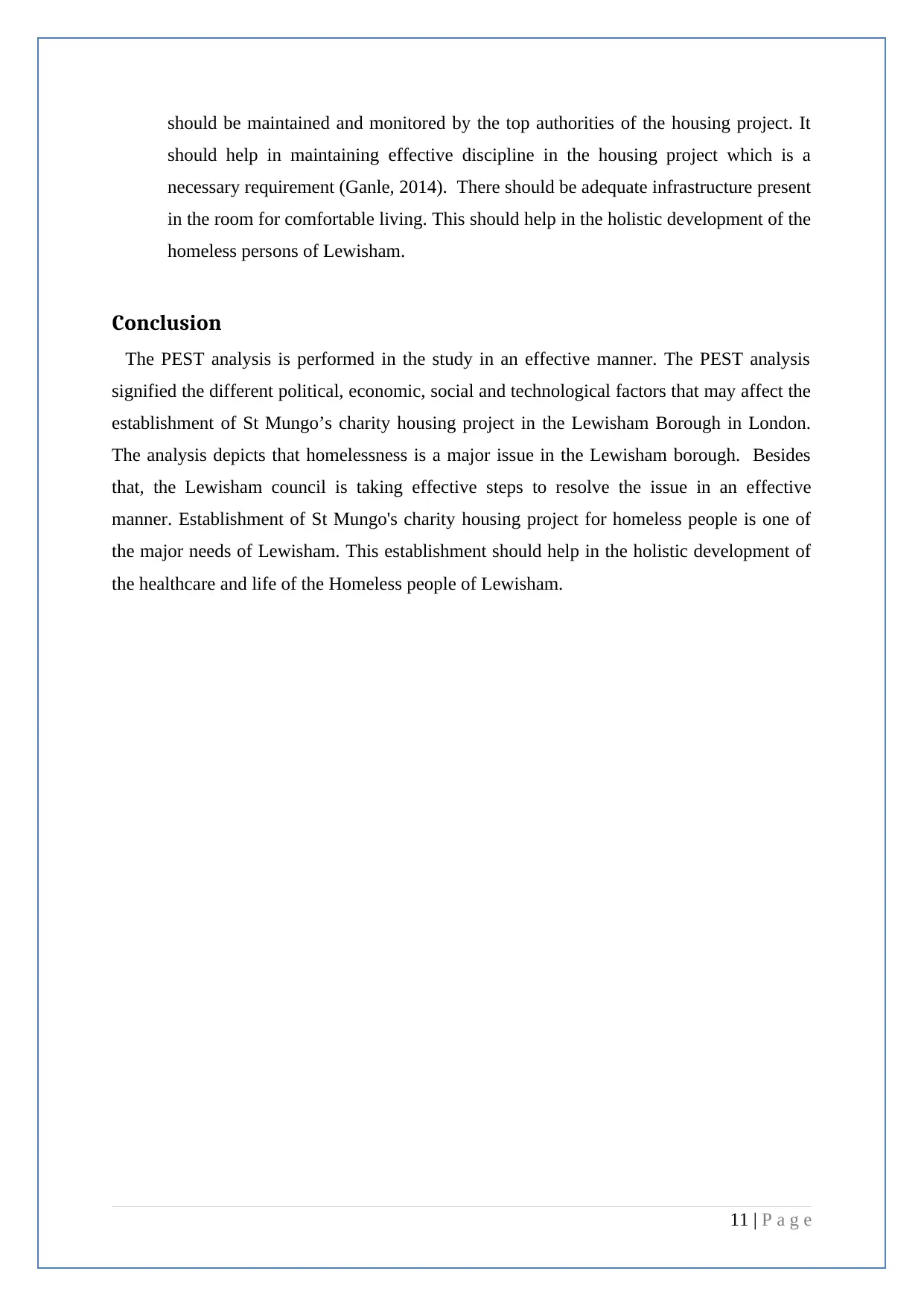
should be maintained and monitored by the top authorities of the housing project. It
should help in maintaining effective discipline in the housing project which is a
necessary requirement (Ganle, 2014). There should be adequate infrastructure present
in the room for comfortable living. This should help in the holistic development of the
homeless persons of Lewisham.
Conclusion
The PEST analysis is performed in the study in an effective manner. The PEST analysis
signified the different political, economic, social and technological factors that may affect the
establishment of St Mungo’s charity housing project in the Lewisham Borough in London.
The analysis depicts that homelessness is a major issue in the Lewisham borough. Besides
that, the Lewisham council is taking effective steps to resolve the issue in an effective
manner. Establishment of St Mungo's charity housing project for homeless people is one of
the major needs of Lewisham. This establishment should help in the holistic development of
the healthcare and life of the Homeless people of Lewisham.
11 | P a g e
should help in maintaining effective discipline in the housing project which is a
necessary requirement (Ganle, 2014). There should be adequate infrastructure present
in the room for comfortable living. This should help in the holistic development of the
homeless persons of Lewisham.
Conclusion
The PEST analysis is performed in the study in an effective manner. The PEST analysis
signified the different political, economic, social and technological factors that may affect the
establishment of St Mungo’s charity housing project in the Lewisham Borough in London.
The analysis depicts that homelessness is a major issue in the Lewisham borough. Besides
that, the Lewisham council is taking effective steps to resolve the issue in an effective
manner. Establishment of St Mungo's charity housing project for homeless people is one of
the major needs of Lewisham. This establishment should help in the holistic development of
the healthcare and life of the Homeless people of Lewisham.
11 | P a g e
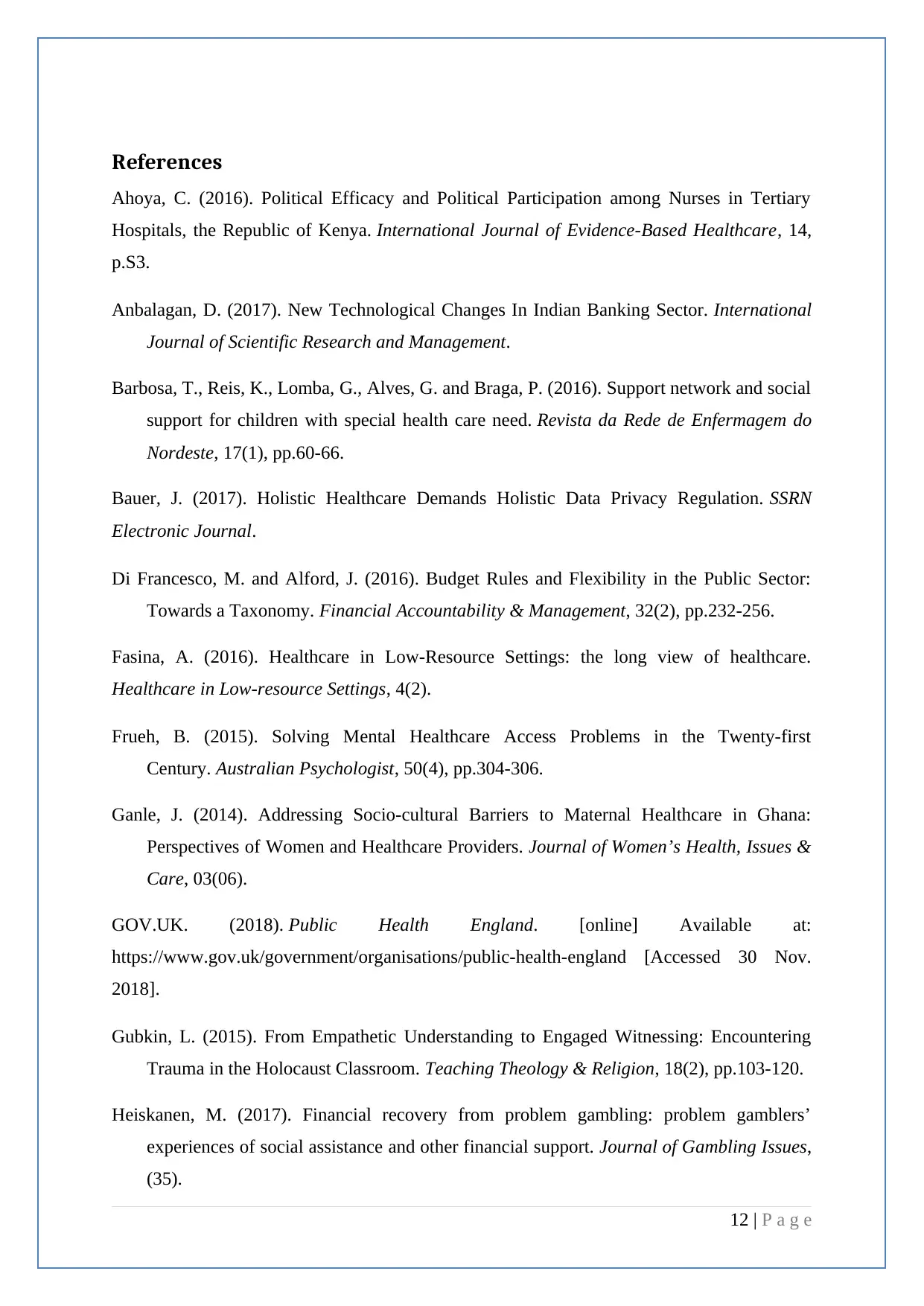
References
Ahoya, C. (2016). Political Efficacy and Political Participation among Nurses in Tertiary
Hospitals, the Republic of Kenya. International Journal of Evidence-Based Healthcare, 14,
p.S3.
Anbalagan, D. (2017). New Technological Changes In Indian Banking Sector. International
Journal of Scientific Research and Management.
Barbosa, T., Reis, K., Lomba, G., Alves, G. and Braga, P. (2016). Support network and social
support for children with special health care need. Revista da Rede de Enfermagem do
Nordeste, 17(1), pp.60-66.
Bauer, J. (2017). Holistic Healthcare Demands Holistic Data Privacy Regulation. SSRN
Electronic Journal.
Di Francesco, M. and Alford, J. (2016). Budget Rules and Flexibility in the Public Sector:
Towards a Taxonomy. Financial Accountability & Management, 32(2), pp.232-256.
Fasina, A. (2016). Healthcare in Low-Resource Settings: the long view of healthcare.
Healthcare in Low-resource Settings, 4(2).
Frueh, B. (2015). Solving Mental Healthcare Access Problems in the Twenty-first
Century. Australian Psychologist, 50(4), pp.304-306.
Ganle, J. (2014). Addressing Socio-cultural Barriers to Maternal Healthcare in Ghana:
Perspectives of Women and Healthcare Providers. Journal of Women’s Health, Issues &
Care, 03(06).
GOV.UK. (2018). Public Health England. [online] Available at:
https://www.gov.uk/government/organisations/public-health-england [Accessed 30 Nov.
2018].
Gubkin, L. (2015). From Empathetic Understanding to Engaged Witnessing: Encountering
Trauma in the Holocaust Classroom. Teaching Theology & Religion, 18(2), pp.103-120.
Heiskanen, M. (2017). Financial recovery from problem gambling: problem gamblers’
experiences of social assistance and other financial support. Journal of Gambling Issues,
(35).
12 | P a g e
Ahoya, C. (2016). Political Efficacy and Political Participation among Nurses in Tertiary
Hospitals, the Republic of Kenya. International Journal of Evidence-Based Healthcare, 14,
p.S3.
Anbalagan, D. (2017). New Technological Changes In Indian Banking Sector. International
Journal of Scientific Research and Management.
Barbosa, T., Reis, K., Lomba, G., Alves, G. and Braga, P. (2016). Support network and social
support for children with special health care need. Revista da Rede de Enfermagem do
Nordeste, 17(1), pp.60-66.
Bauer, J. (2017). Holistic Healthcare Demands Holistic Data Privacy Regulation. SSRN
Electronic Journal.
Di Francesco, M. and Alford, J. (2016). Budget Rules and Flexibility in the Public Sector:
Towards a Taxonomy. Financial Accountability & Management, 32(2), pp.232-256.
Fasina, A. (2016). Healthcare in Low-Resource Settings: the long view of healthcare.
Healthcare in Low-resource Settings, 4(2).
Frueh, B. (2015). Solving Mental Healthcare Access Problems in the Twenty-first
Century. Australian Psychologist, 50(4), pp.304-306.
Ganle, J. (2014). Addressing Socio-cultural Barriers to Maternal Healthcare in Ghana:
Perspectives of Women and Healthcare Providers. Journal of Women’s Health, Issues &
Care, 03(06).
GOV.UK. (2018). Public Health England. [online] Available at:
https://www.gov.uk/government/organisations/public-health-england [Accessed 30 Nov.
2018].
Gubkin, L. (2015). From Empathetic Understanding to Engaged Witnessing: Encountering
Trauma in the Holocaust Classroom. Teaching Theology & Religion, 18(2), pp.103-120.
Heiskanen, M. (2017). Financial recovery from problem gambling: problem gamblers’
experiences of social assistance and other financial support. Journal of Gambling Issues,
(35).
12 | P a g e
Paraphrase This Document
Need a fresh take? Get an instant paraphrase of this document with our AI Paraphraser
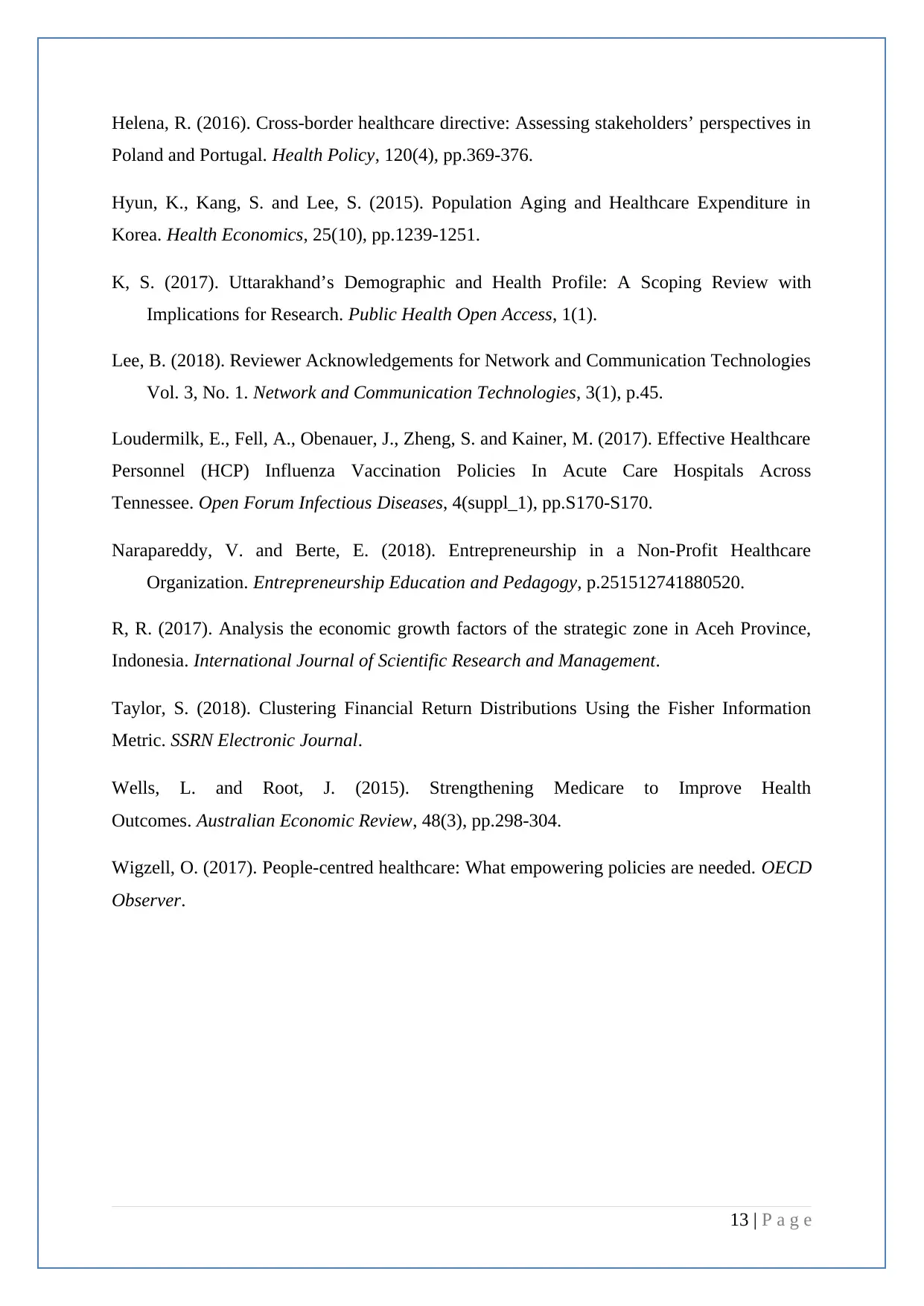
Helena, R. (2016). Cross-border healthcare directive: Assessing stakeholders’ perspectives in
Poland and Portugal. Health Policy, 120(4), pp.369-376.
Hyun, K., Kang, S. and Lee, S. (2015). Population Aging and Healthcare Expenditure in
Korea. Health Economics, 25(10), pp.1239-1251.
K, S. (2017). Uttarakhand’s Demographic and Health Profile: A Scoping Review with
Implications for Research. Public Health Open Access, 1(1).
Lee, B. (2018). Reviewer Acknowledgements for Network and Communication Technologies
Vol. 3, No. 1. Network and Communication Technologies, 3(1), p.45.
Loudermilk, E., Fell, A., Obenauer, J., Zheng, S. and Kainer, M. (2017). Effective Healthcare
Personnel (HCP) Influenza Vaccination Policies In Acute Care Hospitals Across
Tennessee. Open Forum Infectious Diseases, 4(suppl_1), pp.S170-S170.
Narapareddy, V. and Berte, E. (2018). Entrepreneurship in a Non-Profit Healthcare
Organization. Entrepreneurship Education and Pedagogy, p.251512741880520.
R, R. (2017). Analysis the economic growth factors of the strategic zone in Aceh Province,
Indonesia. International Journal of Scientific Research and Management.
Taylor, S. (2018). Clustering Financial Return Distributions Using the Fisher Information
Metric. SSRN Electronic Journal.
Wells, L. and Root, J. (2015). Strengthening Medicare to Improve Health
Outcomes. Australian Economic Review, 48(3), pp.298-304.
Wigzell, O. (2017). People-centred healthcare: What empowering policies are needed. OECD
Observer.
13 | P a g e
Poland and Portugal. Health Policy, 120(4), pp.369-376.
Hyun, K., Kang, S. and Lee, S. (2015). Population Aging and Healthcare Expenditure in
Korea. Health Economics, 25(10), pp.1239-1251.
K, S. (2017). Uttarakhand’s Demographic and Health Profile: A Scoping Review with
Implications for Research. Public Health Open Access, 1(1).
Lee, B. (2018). Reviewer Acknowledgements for Network and Communication Technologies
Vol. 3, No. 1. Network and Communication Technologies, 3(1), p.45.
Loudermilk, E., Fell, A., Obenauer, J., Zheng, S. and Kainer, M. (2017). Effective Healthcare
Personnel (HCP) Influenza Vaccination Policies In Acute Care Hospitals Across
Tennessee. Open Forum Infectious Diseases, 4(suppl_1), pp.S170-S170.
Narapareddy, V. and Berte, E. (2018). Entrepreneurship in a Non-Profit Healthcare
Organization. Entrepreneurship Education and Pedagogy, p.251512741880520.
R, R. (2017). Analysis the economic growth factors of the strategic zone in Aceh Province,
Indonesia. International Journal of Scientific Research and Management.
Taylor, S. (2018). Clustering Financial Return Distributions Using the Fisher Information
Metric. SSRN Electronic Journal.
Wells, L. and Root, J. (2015). Strengthening Medicare to Improve Health
Outcomes. Australian Economic Review, 48(3), pp.298-304.
Wigzell, O. (2017). People-centred healthcare: What empowering policies are needed. OECD
Observer.
13 | P a g e
1 out of 14
Your All-in-One AI-Powered Toolkit for Academic Success.
+13062052269
info@desklib.com
Available 24*7 on WhatsApp / Email
![[object Object]](/_next/static/media/star-bottom.7253800d.svg)
Unlock your academic potential
© 2024 | Zucol Services PVT LTD | All rights reserved.





